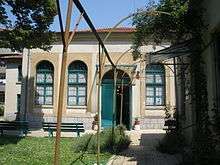Plovdiv Synagogue
The Zion Plovdiv Synagogue is a synagogue in the city of Plovdiv located in Bulgaria. This synagogue is one of the only 2 synagogues that remain active to this day in Bulgaria (with the Sofia Synagogue).
| Zion Plovdiv Synagogue | |
|---|---|
 The Synagogue in Plovdiv | |
| Religion | |
| Affiliation | Judaism |
| Region | Romaniote |
| Rite | Sephardi Jews |
| Ecclesiastical or organizational status | active |
| Location | |
| Location | |
| Geographic coordinates | 42°9′2″N 24°44′27″E |
| Architecture | |
| Style | Ottoman |
| Completed | 1892[1] |
| Website | |
| https://www.plovdivsynagogue.com | |
History
According to the archaeological research a Synagogue had been constructed in ancient Philippopolis dating back to the reign of Emperor Alexander Severus in the first half of 3rd century AD.[2] It is followed by several renovations, the last one – from the beginning of 5th century (M. Martinova).[3] In 1360, when the city was conquered by the Turks certain Jews who emigrated from Aragon in 1492 settled in Philippopolis and built a synagogue called "K. K. Aragon," which was standing in 1540, but is no longer in existence. In 1892[1] following Bulgaria liberation from Ottoman domination in 1878 one of the first synagogues to be erected was the (Zion) Synagogue in Plovdiv. It was built in the remnants of a small courtyard in what was once a large Jewish quarter called Orta Mezar during the Turkish rule. The location of the Sephardic synagogue is now called Tsar Kaloyan Street 13. Before the Second World War, the Jewish quarter had a population of 7000.[4] The Synagogue is one of the best-preserved examples of the so-called "Ottoman-style" synagogues in the Balkans. According to author Ruth E. Gruber, the interior is a "hidden treasure…a glorious, if run-down, burst of color." An exquisite Venetian glass chandelier hangs from the center of the ceiling, which has a richly painted dome. All surfaces are covered in elaborate, Moorish-style, geometric designs in once-bright greens and blues. Torah scrolls are kept in the gilded Aron-ha-Kodesh.[5]
In 1904 the Jewish community possessed three other synagogues: Jeshurun, built in 1710 according to the inscription on a marble slab in the synagogue; Ahabat-Shalom, built in 1880; Shebeṭ Aḥim or Mafṭirim, founded in 1882 by emigrants from Karlovo, whence the Jews fled during the Turko-Russian war (1877-1878).[1]
Rabbis
Since the end of the eighteenth century the following have been chief rabbis of the city:
- Abraham Sidi (according to Zedner, l.c. p. 397, "Sa'id"; 1790-1810);
- Judah Sidi (1810–12), brother of the preceding, and author of Ot Emet, on the laws relating to reading the Torah, Salonica, 1799; and of Ner Miẓwah, on Maimonides' Yad and his Sefer ha-Miẓwot, with indexes to the hermeneutic works of Solomon and Israel Jacob Algazi, ib. 1810-11;
- Abraham ibn Aroglio (1812–19);
- Abraham Ventura (1823–29);
- Moses ha-Levi (1830–32);
- Jacob Finzi (1832–33);
- Ḥayyim ibn Aroglio (1833–57), with Abraham ibn Aroglio joint author of Mayim ha-Ḥayyim, responsa, Salonica, 1846;
- Moses Behmoiras (1857–76); Ḥayyim Meborah (1876-92);
- Ezra Benaroyo who has held office since 1892.[1]
- Shmuel Behar [6]
Legacy
Nowadays, the Jewish community in Bulgaria is very small (863 in 1994)[4] because of the Holocaust, secularity of the local Jewish population due to many years of communism and subsequent Aliya (Jewish immigration to Israel).
In 1994 the synagogue was mostly inactive.[4] but the community is undergoing a revival [7] In 2003 the synagogue was restored. The city's mayor, the U.S. and Israeli ambassadors to Bulgaria, were present at its inauguration. The funding for the restoration of the 19th-century Zion Synagogue. was raised by the U.S. Commission for the Preservation of America's Heritage Abroad (US$26,000)[8] and the London-based Hanadiv Charitable Foundation.[9]
The Plovdiv synagogue is open on Friday night services and on High Holidays. Zion synagogue is also available for guests during the day only after a prescheduled visit made from the temple's website. The synagogue hosts various events connected with the cultural and educational program of the city.[10]
A permanent exhibition about the Jewish life in the city and the region will soon be created and it will present different objects and stories from the community in Plovdiv and Bulgaria.[10]
Photo gallery


 Detail of the dome
Detail of the dome














References
| Wikimedia Commons has media related to Plovdiv Synagogue. |
- This article incorporates text from a publication now in the public domain: Singer, Isidore; et al., eds. (1901–1906). "Philippopolis". The Jewish Encyclopedia. New York: Funk & Wagnalls. Retrieved 3 January 2013.
- Hazan, Elko Z. "Synagogues in Bulgaria: A testimony of eighteen centuries of Jewish presence in the Balkans" (PDF). The Bulgarian Jews. Retrieved 3 January 2013.
- "Synagogue (Plovdiv)". Wikimapia.
- Singer, Natasha (6 March 1994). "Unearthing Bulgarian Jewry in Communism's Rubble". Forward. Archived from the original on 13 March 2016. Retrieved 3 January 2013.
- "Synagogue of Plovdiv, Bulgaria". Heritage Abroad. 5 October 2009. Archived from the original on 7 September 2009. Retrieved 14 June 2010.
- Paldiel, Mordecai (2006). Churches and the Holocaust: Unholy Teaching, Good Samaritans, and Reconciliation. Jersey City, NJ: KTAV. p. 308. ISBN 978-0-88125-908-7.
- Astaire, Libi. "Unlocking Plovdiv's Past" (PDF). Mishpacha. Retrieved 4 January 2013.
- "Synagogue of Plovdiv, Bulgaria". Heritage Abroad. Retrieved 3 January 2013.
- "News at a Glance". Jewish Telegraphic Agency. 11 December 2003. Archived from the original on 4 February 2016. Retrieved 3 January 2013.
- "Home". Plovdiv Synagogue. Retrieved 21 July 2019.
